m (grm.) Tag: sourceedit |
(Adding categories) Tag: categoryselect |
||
| (48 intermediate revisions by 7 users not shown) | |||
| Line 1: | Line 1: | ||
{{at|xx}} |
{{at|xx}} |
||
| + | {| class="wiki-sidebar" |
||
| − | [[File:Starfleet Medical.jpg|thumb|Headquarters on Earth]] |
||
| + | |- |
||
| ⚫ | |||
| + | ! colspan="2" style="text-align:center;" id="Starfleet Medical" | Starfleet Medical |
||
| ⚫ | '''Starfleet Medical''' was a department of [[Starfleet]] dedicated to biological research and treatment of personnel. Based out of [[San Francisco]] on [[Earth]], Starfleet Medical oversaw all Starfleet medical personnel and facilities, which included exercising co-authority, besides the [[captain]], over [[starship]] [[sickbay]] personnel. |
||
| + | |- |
||
| + | | colspan="2" align="center" | [[File:Starfleet Medical Logo.png|200px]] |
||
| + | |- |
||
| + | | colspan="2" class="even" | <center>Seal of Starfleet Medical</center> |
||
| + | |- |
||
| + | | colspan="2" align="left" | |
||
| + | '''Founded''': [[22nd century]]<br/> |
||
| + | '''Affiliation''': [[Starfleet]] ([[United Earth]], [[United Federation of Planets]])<br/> |
||
| + | '''Headquarters''': [[San Francisco]], [[Earth]]<br/> |
||
| + | '''Head''': [[Starfleet Surgeon General]] |
||
| + | |- |
||
| + | | colspan="1" align="center" | [[File:Enterprise NX-01 sickbay entrance.jpg|180px]] |
||
| + | | colspan="1" align="center" | [[File:Constitution class refit sickbay.jpg|180px]] |
||
| + | |- |
||
| + | | class="even" | <center>Entrance to the sickbay of {{NX|01}}. ([[2154]])</center> |
||
| ⚫ | |||
| + | |- |
||
| + | | colspan="1" align="center" | [[File:USS Pasteur bridge.jpg|180px]] |
||
| + | | colspan="1" align="center" | [[File:Starfleet Medical.jpg|180px]] |
||
| + | |- |
||
| + | | class="even" | <center>USS ''Pasteur'' bridge. (''[[Alternate timeline|alternate]] [[anti-time future|2395]]'')</center> |
||
| + | | class="even" | <center>Headquarters on Earth. (''[[Alternate timeline|alternate]] [[2404]]'')</center> |
||
| + | |} |
||
| ⚫ | '''Starfleet Medical''' was a department of (United Earth) [[Starfleet]] dedicated to biological research and treatment of its personnel. Based out of [[San Francisco]] on [[Earth]], Starfleet Medical oversaw all Starfleet medical personnel and facilities, which included exercising co-authority, besides the [[captain]], over [[starship]] [[sickbay]] personnel. |
||
| + | As its emblem, the department carried, from the mid 2150s onward, a stylized version of the double-snaked medical caduceus symbol from ancient [[Greek mythology]]. With the launch of the {{class|NX}}, Starfleet Medical asserted its co-authority over sickbay, by having its symbol prominently featured on the transparent access [[door]]s to sickbay ({{ENT|Broken Bow|Regeneration}}), something repeated two centuries later with the {{class|Galaxy}}. ({{TNG|Remember Me}}) In the 2270s and the 2280's (when the emblem was shortly replaced with a variant design), the emblem was worn by starship medical personnel on their garments, when on duty in sickbay. ({{film|1|}}, {{film|2}}) |
||
| ⚫ | |||
| + | |||
| ⚫ | |||
In the [[23rd century]], an office existed known as the [[Starfleet Surgeon General]] which held some command authority over Starfleet Medical, including the power to relieve starship [[medical officer]]s for incompetence. ({{TOS|Turnabout Intruder}}) |
In the [[23rd century]], an office existed known as the [[Starfleet Surgeon General]] which held some command authority over Starfleet Medical, including the power to relieve starship [[medical officer]]s for incompetence. ({{TOS|Turnabout Intruder}}) |
||
| Line 11: | Line 37: | ||
Starfleet Medical contained many diagnostic and treatment wards, utilizing the most advanced technologies. Long-term facilities were available to care for seriously ill patients. ({{VOY|Endgame}}) |
Starfleet Medical contained many diagnostic and treatment wards, utilizing the most advanced technologies. Long-term facilities were available to care for seriously ill patients. ({{VOY|Endgame}}) |
||
| − | It was also responsible for all medical research activities in the Federation. [[Researcher]]s were required to obtain approval from Starfleet Medical before proceeding with new treatments and [[medication]]s. |
+ | It was also responsible for all medical research activities in the Federation. [[Researcher]]s were required to obtain approval from Starfleet Medical before proceeding with new treatments and [[medication]]s. ({{TNG|Ethics}}) |
Starfleet Medical was also responsible for the regulation and training of the various [[counselor]]s in Starfleet. ({{DS9|Afterimage}}) |
Starfleet Medical was also responsible for the regulation and training of the various [[counselor]]s in Starfleet. ({{DS9|Afterimage}}) |
||
| Line 18: | Line 44: | ||
Starfleet Medical was also the [[parent]] of the [[Starfleet Dental]] sub-division. ({{DS9|Paradise Lost}}) |
Starfleet Medical was also the [[parent]] of the [[Starfleet Dental]] sub-division. ({{DS9|Paradise Lost}}) |
||
| + | |||
| + | As a subsidiary division of Starfleet, Starfleet Medical is subject to their [[Starfleet General Orders and Regulations|General Orders and Regulations]] and several of those are specifically directed at the division, including, |
||
| + | *'''Regulation 121''' (Section A): The [[chief medical officer]] has the power to relieve an officer or crewman of his or her duties (including one of superior rank) if, in the CMO's professional judgment, the individual is medically unfit, compromised by an alien intelligence ({{TNG|Lonely Among Us}}), or otherwise exhibits behavior that indicates seriously impaired judgment. A Starfleet officer can face court martial for failing to submit to such a relief. ({{VOY|Year of Hell, Part II}}) |
||
| + | {{bginfo|In an alternate timeline generated by the [[Krenim]], Captain Kathryn Janeway was relieved of her duties under this regulation by ''Voyager''{{'}}s EMH, who had been observing reckless behavior on her part for weeks and attributed it to [[Traumatic Stress Syndrome]]. Janeway refused to surrender her duties, as she felt her efforts to bring her crew home were of more importance. Since security personnel had abandoned the ship, the EMH had no means of enforcing the regulation anyway. Janeway's actions later resulted in the erasure of this timeline, so the issue was nonexistent.|In [[2375]] aboard the [[Silver Blood]] ''Voyager'', [[Neelix]] became, unofficially, chief medical officer after the loss of The Doctor. He threatened in a lighthearted manner to use his "authority" to relieve Janeway of her duties when she insisted on remaining in command although [[fatigue]]d. ({{VOY|Course: Oblivion}})}} |
||
| + | *'''Unnumbered protocol''': A [[physician]] must be present when administering [[arithrazine]]. ({{VOY|The Omega Directive}}) |
||
| + | {{bginfo|A [[captain]], when acting in accordance with the [[Omega Directive]], could override this protocol.}} |
||
== Events == |
== Events == |
||
[[File:Starfleet and Vulcan personnel discuss Klaang.jpg|thumb|Interior of Starfleet Medical in 2151]] |
[[File:Starfleet and Vulcan personnel discuss Klaang.jpg|thumb|Interior of Starfleet Medical in 2151]] |
||
| − | In [[2151]], the [[Klingon]] courier [[Klaang]] was brought to Starfleet Medical after being shot with a [[plasma rifle]] while on Earth. There, he was treated by Doctor [[Phlox]], who had been stationed at Starfleet Medical through the [[Interspecies Medical Exchange]]. [[Captain]] [[Jonathan Archer|Archer]] subsequently asked Phlox to join his crew as the [[chief medical officer]] aboard {{EnterpriseNX}}. ({{ENT|Broken Bow}}) |
+ | In [[2151]], the [[Klingon]] courier [[Klaang]] was brought to Starfleet Medical after being shot with a [[plasma rifle]] while on Earth. There, he was treated by [[Doctor]] [[Phlox]], who had been stationed at Starfleet Medical through the [[Interspecies Medical Exchange]]. [[Captain]] [[Jonathan Archer|Archer]] subsequently asked Phlox to join his crew as the [[chief medical officer]] aboard {{EnterpriseNX}}. ({{ENT|Broken Bow}}) |
{{bginfo|The interior of the Starfleet Medical facility shown in "Broken Bow" was a redress of the set later used to represent ''Enterprise''{{'}}s [[armory]] (which was built for the episode but not used therein). ("Broken Bow" [[text commentary]], [[ENT Season 1 DVD]]) In its Starfleet Medical guise, the set also included a reused pair of [[Ten Forward]] doors from ''[[Star Trek: The Next Generation]]''. ''{{DrexFiles|2009/04/29/nx-sickbay/}}'' Presumably owing to Phlox's presence in the medical ward, the text commentary for "Broken Bow" refers to the room as the "Interspecies Medical Exchange ward." Other than Phlox being in the room, however, no correlation between that area of Starfleet Medical and the IME is given in the installment's revised final draft script nor in the actual episode. ''[http://leethomson.myzen.co.uk/Star_Trek/5_Enterprise/Enterprise_1x01_-_Broken_Bow.txt]''}} |
{{bginfo|The interior of the Starfleet Medical facility shown in "Broken Bow" was a redress of the set later used to represent ''Enterprise''{{'}}s [[armory]] (which was built for the episode but not used therein). ("Broken Bow" [[text commentary]], [[ENT Season 1 DVD]]) In its Starfleet Medical guise, the set also included a reused pair of [[Ten Forward]] doors from ''[[Star Trek: The Next Generation]]''. ''{{DrexFiles|2009/04/29/nx-sickbay/}}'' Presumably owing to Phlox's presence in the medical ward, the text commentary for "Broken Bow" refers to the room as the "Interspecies Medical Exchange ward." Other than Phlox being in the room, however, no correlation between that area of Starfleet Medical and the IME is given in the installment's revised final draft script nor in the actual episode. ''[http://leethomson.myzen.co.uk/Star_Trek/5_Enterprise/Enterprise_1x01_-_Broken_Bow.txt]''}} |
||
In [[2365]], Dr. [[Beverly Crusher]] served with the headquarters of Starfleet Medical. ({{TNG|The Child|Evolution}}) |
In [[2365]], Dr. [[Beverly Crusher]] served with the headquarters of Starfleet Medical. ({{TNG|The Child|Evolution}}) |
||
| − | Dr. [[Toby Russell]] had submitted a request to test the [[ |
+ | Dr. [[Toby Russell]] had submitted a request to test the [[genetronic replicator]] on [[humanoid]]s three times by [[2368]]. Each time, Starfleet Medical refused to allow use of the technology. ({{TNG|Ethics}}) |
In [[2369]], Doctor [[Julian Bashir]] told a [[Unnamed Bajorans#Bajoran Woman 2|Bajoran woman]] he dated in the [[Replimat]] about his [[exam]] at Starfleet Medical. ({{DS9|Q-Less}}) Shortly thereafter, he told [[Major]] [[Kira Nerys]] that he learned, in his first year at the medical school, never to trust a [[tricorder]]. ({{DS9|The Passenger}}) |
In [[2369]], Doctor [[Julian Bashir]] told a [[Unnamed Bajorans#Bajoran Woman 2|Bajoran woman]] he dated in the [[Replimat]] about his [[exam]] at Starfleet Medical. ({{DS9|Q-Less}}) Shortly thereafter, he told [[Major]] [[Kira Nerys]] that he learned, in his first year at the medical school, never to trust a [[tricorder]]. ({{DS9|The Passenger}}) |
||
| Line 36: | Line 68: | ||
In [[2374]], Starfleet Medical hosted [[Casperia Prime medical conference|a conference]] on [[Casperia Prime]]. ({{DS9|Inquisition}}) |
In [[2374]], Starfleet Medical hosted [[Casperia Prime medical conference|a conference]] on [[Casperia Prime]]. ({{DS9|Inquisition}}) |
||
| − | By [[2375]], one of the standards established by Starfleet Medical stated that soldiers could not be posted on a single assignment for a period exceeding ninety [[day]]s. ({{DS9|The Siege of AR-558}}) |
+ | By [[2375]], one of the standards established by Starfleet Medical stated that soldiers could not be posted on a single combat assignment for a period exceeding ninety [[day]]s. ({{DS9|The Siege of AR-558}}) |
Odo contracted the morphogenic virus in late [[2375]], a disease that had already begun killing the Founders of the [[Dominion]]. Starfleet Medical was unwilling to assist Julian Bashir in his research for a cure and refused him access to Odo's [[medical file]], believing Bashir was trying to help the enemy. When [[Benjamin Sisko]] requested the file, they sent a copy of [[Mora Pol]]'s medical file on Odo, taken decades previously, in an attempt to hinder Bashir's efforts. ({{DS9|When It Rains...}}) |
Odo contracted the morphogenic virus in late [[2375]], a disease that had already begun killing the Founders of the [[Dominion]]. Starfleet Medical was unwilling to assist Julian Bashir in his research for a cure and refused him access to Odo's [[medical file]], believing Bashir was trying to help the enemy. When [[Benjamin Sisko]] requested the file, they sent a copy of [[Mora Pol]]'s medical file on Odo, taken decades previously, in an attempt to hinder Bashir's efforts. ({{DS9|When It Rains...}}) |
||
| Line 56: | Line 88: | ||
{{Branches of Starfleet}} |
{{Branches of Starfleet}} |
||
| + | ==Background information== |
||
| ⚫ | |||
| + | {| class="wiki-sidebar" |
||
| ⚫ | |||
| + | |- |
||
| ⚫ | |||
| + | | colspan="1" align="center" | [[File:2270s Starfleet Medical badge.jpg|180px]] |
||
| + | | colspan="1" align="center" | [[File:2280s Starfleet Medical insignia pin.jpg|180px]] |
||
| + | |- |
||
| + | | class="even" | <center>2270s Starfleet Medical badge</center> |
||
| + | | class="even" | <center>2280s Starfleet Medical insignia pin</center> |
||
| + | |- |
||
| + | | colspan="2" align="center" | [[File:Medkits.jpg|360px]] |
||
| + | |- |
||
| + | | colspan="2" | <center>24th century medkits featuring the caduceus</center> |
||
| + | |- |
||
| + | | colspan="1" align="center" | [[File:SpecialSSCrests.jpg|180px]] |
||
| + | | colspan="1" align="center" | [[File:Symbol and Spock.jpg|180px]] |
||
| + | |- |
||
| + | | class="even" | <center>Rod of Asclepius medical symbol (r)</center> |
||
| + | | class="even" | <center>Aquan version of the symbol</center> |
||
| + | |} |
||
| + | The stylized medical caduceus symbol was designed by [[Lee Cole]], the graphic designer for {{film|1}} and was seen as signage in sickbay and more prominently as badges on garments of medical personnel on duty in sickbay. For {{film|2}}, Cole came up with a more artful variant which was now worn as a pin instead as a badge, and was only featured in this production. Cole's successor for the modern television franchise, Scenic Artist [[Mike Okuda]], adopted her original design, and the symbol was most frequently seen throughout the run of the modern television franchise on the new [[medkit]]s, introduced at the start of ''[[Star Trek: The Next Generation]]''{{'}} s [[TNG Season 4|fourth season]]. (''[[Star Trek: The Next Generation - The Continuing Mission]]'', p. 117) Okuda also retro-applied the symbol as signage throughout the sickbay of the {{NX|01}} in ''[[Star Trek: Enterprise]]'', thereby [[canon]]ically establishing that the symbol had been in use for over two centuries. ({{ENT|Broken Bow|Dear Doctor}}) |
||
| + | |||
| + | Yet, both Cole and Okuda, unwittingly perhaps, perpetuated the misconception, especially held in the United States, that the double serpent-entwined caduceus was the proper {{w|Caduceus as a symbol of medicine|symbol for medicine and healing}}, which it was not. The proper symbol has traditionally been the {{w|Rod of Asclepius}}, a single serpent-entwined rod, lacking the wings, wielded by [[Asclepius]], in Greek mythology the [[god]] of healing and medicine. The caduceus on the other hand, was the rod carried by [[Hermes]], the god of travelers, commerce and thieves, and his rod has since then become the symbol of commerce. Hermes was concurrently the messenger of the gods, and was therefore often depicted with wings on his helmet and sandals, indicative of speedy delivery, hence the wings on his rod. |
||
| + | |||
| + | The proper symbol was on at least three occasions featured in a ''Star Trek'' production; On Doctor [[Leonard McCoy]]'s [[SS]] uniform as a left sleeve patch in the ''[[Star Trek: The Original Series]]'' [[TOS Season 2|second season]] episode {{e|Patterns of Force}}, and as a slip-over lapel on the shoulder strap of the uniform of a [[Unnamed Hirogen#Hirogen Beta SS Medic (2374)|Beta Hirogen SS medic]] in ''[[Star Trek: Voyager]]''{{'}}s [[VOY Season 4|fourth season]] episode {{e|The Killing Game, Part II}}. In a somewhat artistic interpretation, the proper symbol was also seen as the symbol representing the advanced medical science technology of the [[Aquan]]s in the ''[[Star Trek: The Animated Series]]'' episode {{e|The Ambergris Element}}. |
||
| + | |||
| + | [[File:USAAF medical collar pin.jpg|thumb|[[1940s]] USAAF medical collar pin]] |
||
| + | For unclear reasons, the misconception originated in the United States when the caduceus was introduced shortly before the American Civil War as the symbol for the US Medical Corps. Surviving Civil War [[uniform]]s of the Union Medical Corps show the symbol embroided on a green band, worn as a chevron on both sleeves. (''Echoes of Glory: Arms and Equipment of the Union'', Time-Life Books, 1991, pp. 158-159) Incidentally, the color green was adhered to in the first six {{Star Trek films}} as the color signifying medical divisions, shown in the fields of their personnel's insignia as well as being the color of their undershirts, before returning to the various shades of blue, the generic color signifying all [[sciences division]]s, as already established in ''The Original Series''. |
||
| + | |||
| + | The misconception was perpetuated for nearly a century in the US armed forces until the interbellum years, when the medical branches of the US Airforce [http://www.airforcemedicine.af.mil/afmsheritage/] and the US Navy [http://www.med.navy.mil/Pages/default.aspx] started to carry the proper symbol on their coat of arms. The US Army followed suit (as have US civilian medical institutions), but the armed forces still continue to use the caduceus for their individual (regimental) badges and insignia, as could be seen on the uniform of [[United States Army Air Forces|USAAF]] [[nurse]] [[Faith Garland]] in the ''[[Star Trek: Deep Space Nine]]'' [[DS9 Season 4|season four]] episode {{e|Little Green Men}}. |
||
| + | |||
[[de:Medizinisches Corps der Sternenflotte]] |
[[de:Medizinisches Corps der Sternenflotte]] |
||
[[ja:宇宙艦隊医療部]] |
[[ja:宇宙艦隊医療部]] |
||
[[nl:Starfleet medisch]] |
[[nl:Starfleet medisch]] |
||
| ⚫ | |||
| ⚫ | |||
| ⚫ | |||
| + | [[Category:Starfleet]] |
||
Revision as of 04:59, 10 April 2016
AT: "xx"
| Starfleet Medical | |
|---|---|
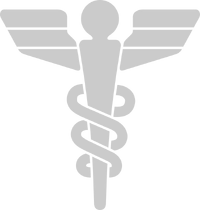
| |
|
Founded: 22nd century | |

|
File:Constitution class refit sickbay.jpg |
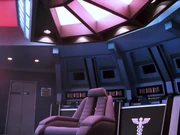
|
File:Starfleet Medical.jpg |
Starfleet Medical was a department of (United Earth) Starfleet dedicated to biological research and treatment of its personnel. Based out of San Francisco on Earth, Starfleet Medical oversaw all Starfleet medical personnel and facilities, which included exercising co-authority, besides the captain, over starship sickbay personnel.
As its emblem, the department carried, from the mid 2150s onward, a stylized version of the double-snaked medical caduceus symbol from ancient Greek mythology. With the launch of the NX-class, Starfleet Medical asserted its co-authority over sickbay, by having its symbol prominently featured on the transparent access doors to sickbay (ENT: "Broken Bow", "Regeneration"), something repeated two centuries later with the Galaxy-class. (TNG: "Remember Me") In the 2270s and the 2280's (when the emblem was shortly replaced with a variant design), the emblem was worn by starship medical personnel on their garments, when on duty in sickbay. (Star Trek: The Motion Picture, Star Trek II: The Wrath of Khan)
In an alternate timeline, Starfleet Medical was known to operate at least one hospital ship of its own, the USS Pasteur, as indicated by its emblems on the primary hull and their prominent presence on the bridge. (TNG: "All Good Things...")
In the 23rd century, an office existed known as the Starfleet Surgeon General which held some command authority over Starfleet Medical, including the power to relieve starship medical officers for incompetence. (TOS: "Turnabout Intruder")
Responsibilities
Starfleet Medical contained many diagnostic and treatment wards, utilizing the most advanced technologies. Long-term facilities were available to care for seriously ill patients. (VOY: "Endgame")
It was also responsible for all medical research activities in the Federation. Researchers were required to obtain approval from Starfleet Medical before proceeding with new treatments and medications. (TNG: "Ethics")
Starfleet Medical was also responsible for the regulation and training of the various counselors in Starfleet. (DS9: "Afterimage")
It maintained a large database of medical information available to Starfleet personnel. (TNG: "Realm of Fear", "Genesis")
Starfleet Medical was also the parent of the Starfleet Dental sub-division. (DS9: "Paradise Lost")
As a subsidiary division of Starfleet, Starfleet Medical is subject to their General Orders and Regulations and several of those are specifically directed at the division, including,
- Regulation 121 (Section A): The chief medical officer has the power to relieve an officer or crewman of his or her duties (including one of superior rank) if, in the CMO's professional judgment, the individual is medically unfit, compromised by an alien intelligence (TNG: "Lonely Among Us"), or otherwise exhibits behavior that indicates seriously impaired judgment. A Starfleet officer can face court martial for failing to submit to such a relief. (VOY: "Year of Hell, Part II")
- Unnumbered protocol: A physician must be present when administering arithrazine. (VOY: "The Omega Directive")
Events
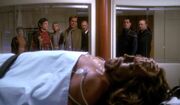
Interior of Starfleet Medical in 2151
In 2151, the Klingon courier Klaang was brought to Starfleet Medical after being shot with a plasma rifle while on Earth. There, he was treated by Doctor Phlox, who had been stationed at Starfleet Medical through the Interspecies Medical Exchange. Captain Archer subsequently asked Phlox to join his crew as the chief medical officer aboard Enterprise NX-01. (ENT: "Broken Bow")
In 2365, Dr. Beverly Crusher served with the headquarters of Starfleet Medical. (TNG: "The Child", "Evolution")
Dr. Toby Russell had submitted a request to test the genetronic replicator on humanoids three times by 2368. Each time, Starfleet Medical refused to allow use of the technology. (TNG: "Ethics")
In 2369, Doctor Julian Bashir told a Bajoran woman he dated in the Replimat about his exam at Starfleet Medical. (DS9: "Q-Less") Shortly thereafter, he told Major Kira Nerys that he learned, in his first year at the medical school, never to trust a tricorder. (DS9: "The Passenger")
When Doctor Crusher was faced with a board of inquiry in 2369, she told Guinan she could already hear Admiral Brooks telling Crusher how she'd disgraced Starfleet Medical. (TNG: "Suspicions")
Odo visited Starfleet Medical in 2372, where they performed medical tests on him to gain information that could be used against the Founders. It was during this examination that Odo was infected with a morphogenic virus by the covert intelligence group Section 31. (DS9: "When It Rains...")
In 2374, Starfleet Medical hosted a conference on Casperia Prime. (DS9: "Inquisition")
By 2375, one of the standards established by Starfleet Medical stated that soldiers could not be posted on a single combat assignment for a period exceeding ninety days. (DS9: "The Siege of AR-558")
Odo contracted the morphogenic virus in late 2375, a disease that had already begun killing the Founders of the Dominion. Starfleet Medical was unwilling to assist Julian Bashir in his research for a cure and refused him access to Odo's medical file, believing Bashir was trying to help the enemy. When Benjamin Sisko requested the file, they sent a copy of Mora Pol's medical file on Odo, taken decades previously, in an attempt to hinder Bashir's efforts. (DS9: "When It Rains...")
Species 8472 recreated Starfleet Medical as part of their Earth simulation in 2375. (VOY: "In the Flesh")
In an alternate timeline, in which it took the USS Voyager twenty-three years to return to Earth, Tuvok was sent to live at Starfleet Medical, having succumbed to a mental condition while aboard in 2378. The holographic doctor of Voyager was working at the medical facility in 2404 and was helping Tuvok, as well as working on the project to develop chronexaline. (VOY: "Endgame")
Personnel
Template:Branches of Starfleet
Background information
| File:2270s Starfleet Medical badge.jpg | File:2280s Starfleet Medical insignia pin.jpg |

| |
| File:SpecialSSCrests.jpg | 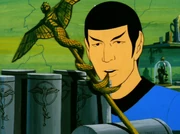
|
The stylized medical caduceus symbol was designed by Lee Cole, the graphic designer for Star Trek: The Motion Picture and was seen as signage in sickbay and more prominently as badges on garments of medical personnel on duty in sickbay. For Star Trek II: The Wrath of Khan, Cole came up with a more artful variant which was now worn as a pin instead as a badge, and was only featured in this production. Cole's successor for the modern television franchise, Scenic Artist Mike Okuda, adopted her original design, and the symbol was most frequently seen throughout the run of the modern television franchise on the new medkits, introduced at the start of Star Trek: The Next Generation' s fourth season. (Star Trek: The Next Generation - The Continuing Mission, p. 117) Okuda also retro-applied the symbol as signage throughout the sickbay of the Enterprise NX-01 in Star Trek: Enterprise, thereby canonically establishing that the symbol had been in use for over two centuries. (ENT: "Broken Bow", "Dear Doctor")
Yet, both Cole and Okuda, unwittingly perhaps, perpetuated the misconception, especially held in the United States, that the double serpent-entwined caduceus was the proper symbol for medicine and healing, which it was not. The proper symbol has traditionally been the Rod of Asclepius, a single serpent-entwined rod, lacking the wings, wielded by Asclepius, in Greek mythology the god of healing and medicine. The caduceus on the other hand, was the rod carried by Hermes, the god of travelers, commerce and thieves, and his rod has since then become the symbol of commerce. Hermes was concurrently the messenger of the gods, and was therefore often depicted with wings on his helmet and sandals, indicative of speedy delivery, hence the wings on his rod.
The proper symbol was on at least three occasions featured in a Star Trek production; On Doctor Leonard McCoy's SS uniform as a left sleeve patch in the Star Trek: The Original Series second season episode "Patterns of Force", and as a slip-over lapel on the shoulder strap of the uniform of a Beta Hirogen SS medic in Star Trek: Voyager's fourth season episode "The Killing Game, Part II". In a somewhat artistic interpretation, the proper symbol was also seen as the symbol representing the advanced medical science technology of the Aquans in the Star Trek: The Animated Series episode "The Ambergris Element".
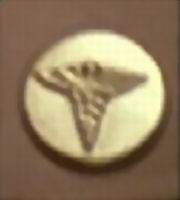
1940s USAAF medical collar pin
For unclear reasons, the misconception originated in the United States when the caduceus was introduced shortly before the American Civil War as the symbol for the US Medical Corps. Surviving Civil War uniforms of the Union Medical Corps show the symbol embroided on a green band, worn as a chevron on both sleeves. (Echoes of Glory: Arms and Equipment of the Union, Time-Life Books, 1991, pp. 158-159) Incidentally, the color green was adhered to in the first six Star Trek films as the color signifying medical divisions, shown in the fields of their personnel's insignia as well as being the color of their undershirts, before returning to the various shades of blue, the generic color signifying all sciences divisions, as already established in The Original Series.
The misconception was perpetuated for nearly a century in the US armed forces until the interbellum years, when the medical branches of the US Airforce [3] and the US Navy [4] started to carry the proper symbol on their coat of arms. The US Army followed suit (as have US civilian medical institutions), but the armed forces still continue to use the caduceus for their individual (regimental) badges and insignia, as could be seen on the uniform of USAAF nurse Faith Garland in the Star Trek: Deep Space Nine season four episode "Little Green Men".
